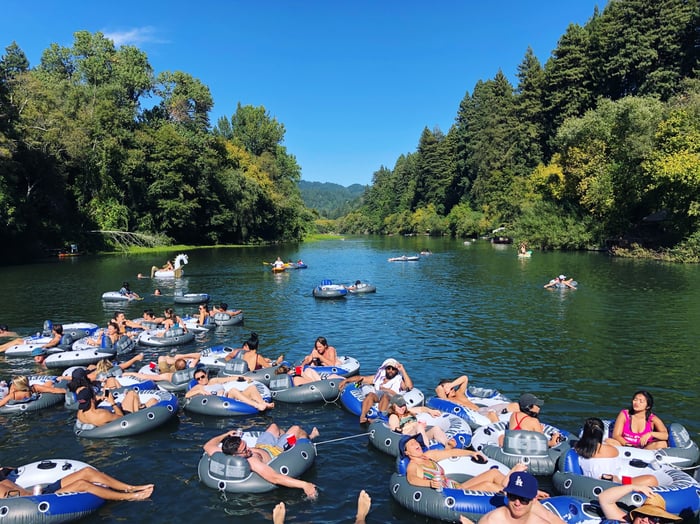It’s hard - if not impossible - to nail every aspect and element of a company retreat. Every successful offsite and retreat planner has been through the high’s and low’s of managing vendors while making sure everyone is comfortable, safe and inspired on the retreat. Just look around on the internet, it’s littered with all types of businesses providing “content” on how to plan and manage a successful retreat.
When we’re investigating these articles, we tend to ask ourselves how many company retreats this writer actually planned? We do love BUFFER’s approach here, however.
The truth is, there is no magic bullet in planning the perfect company retreat for your team. Well, we haven’t found it. If you do, please email us immediately at info@theoffsiteco.com.
We’re here because it is, literally, all that we do at The Offsite Co. Day and night, Monday through Sunday; we’re either pitching, planning or on-site executing retreats and offsites. We would be CRAZY if we didn’t obsess over finding ways to streamline the process while maximizing the impact of these experiences.
Here are some quick Retreat Planning Hacks we recommend and we use in our process everyday:
Retreat Planning Hack #1: Hire The Offsite Co.
Retreat Planning Hack #2: Create an early Per Person Budget
Even if you have to make one up from the beginning, put a number in a spreadsheet and call that your budget. Your next step is to reverse engineer the retreat based on that number. This number will help drive you in the right direction with every element of the retreat.
The good news, the number can move! If you find the perfect venue or an experience you know your team will love, you can find ways to either move things around inside of the budget or you can pitch your team for more dollars.

Streamlined Retreat Planning
Retreat Planning Hack #5: Find Unique Venues
It takes a bit more time but trust us, this is time well spent. We use out-of-market sites to source the best possible venue options based on the goals, requirements and budget. Wedding websites are a really great place to start for discovering a few unique venue options.
This part is such an important part of our process that we have now accumulated a database of over 3k venues with negotiated pricing.
Retreat Planning Hack #6: Goals & Requirements
Create a list of Goals and Requirements with your team. Go crazy here. Fill the both columns with as many ideas you can. We can always refine from the first draft. Once you have this sufficiently filled out and your leadership team has had their input, go to Hack #7.
Some examples of Goals we see are as follows: Inspire team around the company vision for the next year, Create an organic way for team members to bond, Have a fun and competitive team building event, Announce the launch of a new internal program, Connect new hires with colleagues outside of their department, Better connect the team outside of work, Inspire everyone to understand why their specific role is so important to direction and functionality of the company, Celebrate a Funding Round…and so on.
Some of examples of Requirements are as follows: Transportation for X People, These 10 people probably want their own room, All meals must have a vegetarian option, Workspace needs to fit three all-hands sessions, 2-4 rooms for break out sessions, Venue must be a buyout, We must have Karaoke…and so on!
Retreat Planning Hack #7: Build a First Draft Itinerary
Now that you understand your teams goals and requirements on the retreat, we can start building a rough itinerary. Remember, this is an early stage ideation process. This should be a fun part. Create rough timelines for each block.
We typically block these off in the following manner: Travel / Work Sessions (All-Hands) / Work Sessions (Breakout) / Experiences (Team Bonding) / Downtime / Food and Drink
Feel free to get creative with each block here and jot down ideas for how your team might execute the goal within each block.
As an example, for TRAVEL - we might present things like Bus-2-Bus trivia competitions. Or for teams carpooling, The Drivable Scavenger Hunt, where each car has to accomplish a set of tasks of the way to the retreat.
Retreat Planning Hack #8: Formal Committee’s Make Everything Harder
In our experience, formal internal committee’s focused on the annual retreat create more headache’s than are necessary. Too many cooks in the kitchen some might say.
We do recommend having an informal team working together on the retreat however. As long as you are the point-person and there is one final decision maker. We highly recommend asking for input to a select few on the high-level direction of a retreat.
An easy way to do this to build the rough draft itinerary on your own with your CEO or whoever the final decision maker is. Once you have that done, schedule a meeting with a few of your Culture Champions and ask them for their ideas of how to execute inside of those goals and requirements.
Retreat Planning Hack #9: Use Project Management Software
This is a must-have. If you’re managing this retreat without outside expertise, there are going to be A LOT of variables every step of the way. Software like Trello, can help organize everything into one system and will keep you accountable for action items along the way.
We use project management software by breaking down the crucial elements of the retreat into separate buckets. For venue options, for instance, we will load every venue available for your retreat with pricing, location, # of beds, inclusions in quote etc. into one bucket. You can easily see how each venue compares to the others and will help you make the best decision.
Retreat Planning Hack #10: Hire On-Site Help
The worst scenario plays out everyday at companies around the country. One person inside of your company is going to research, plan, manage and execute this retreat for your entire team. They are going to be STRESSED OUT leading up to the retreat, and especially, during the retreat.
Hiring on-site help will allow you or your go-to internal planner to actually be able to enjoy the retreat like everyone else. There are some really cost effective ways to do this. Pay someone at the venue a bit extra to manage different aspects of the retreat.


